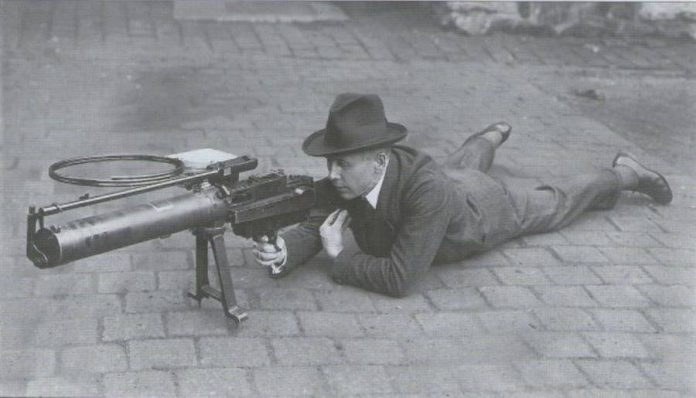Today, the idea of a flying tank seems rather absurd. Really, where at your disposal there are transport aircraft, able to move the tank from one point to another world, on the wings pridelyvanii a heavily armored combat vehicle somehow did not think about it. However, in the 1930s of the last century it was very different, aircraft, able to transfer the tanks by air, simply did not exist, so the idea of creating a full-fledged aviatanka worried minds of many designers around the world. In this case, the best known US-Soviet projects in this area.
The First World War gave the military new types of weapons, among which were the tanks and warplanes. And if the tanks appeared on the battlefield is already in the midst of war, the planes known and previously failed to establish itself as a fairly effective weapon. In this war many countries have gained tremendous experience fighting, who claimed their thoughts on the mass of the negative effects of trench warfare, military thought moving to a war of motors, lightning war, deep offensive operations. In these circumstances, more and more attention was the question of military diversion main striking force of ground troops, tanks which became, to the desired impact direction. It is in this environment, and the idea of cross-breeding between a tank and aircraft.
Thus the primacy of the idea of a flying tank belongs to the famous American designer George Walter Christie, who presented his project of a flying tank back in 1932 year. He created the concept of the new armored vehicles, which would be able to move through the air. American journalists met the idea with great enthusiasm, newspaper published the scheme of the flying tank Christie, which the, according to representatives of the media, I would be able to save America from any attacks. At the same time the idea was to be expected a huge number of skeptics, and only really have no doubt Rights Project, perhaps, he was only Christy. Designer always with fanatical tenacity was to achieve goals, even when not in the best of terms with the US government.
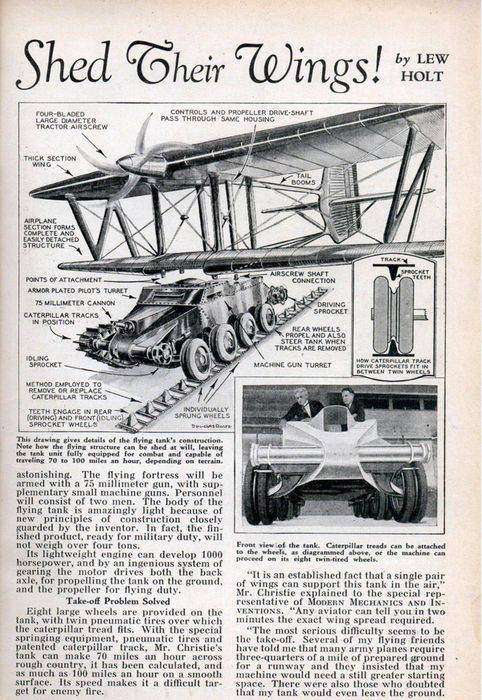
The first phase of its project, George Walter Christie believed he created Bezbashenny tank M.1932, which was made from duralumin. does not exceed the weight of the tank 4 tonnes, thus it was planned to equip the 75 mm gun. The tank was supposed to get the engine power 750 HP. speed of the tank on tracks was to be 90 kmh. The crew consisted of two persons of the driver and commander-arrow. According to the draft Christie tank was planned to equip the biplane wing box, which is attached to the tail. Front propeller had to be mounted on the upper wing. Distance, required for take-off was about 200 m. The first half of the way the tank was supposed to accelerate their progress on the tracks, and then diverted to drive the propeller, takeoff must have occurred when the speed 130 kmh.
But that, which seemed simple enough on paper in the form of a draft, It was very difficult to bring to life. Great complexity was the implementation of a remote drive switching from the tracks on the propeller and back. For the time period it was a rather complicated problem. Over time, the designer finally soured relations with the US Department of Arms, where they were unhappy with his talks with the Soviet Union. Ultimately, the project was not implemented. However, the idea of a flying tank flew across the ocean, conquered the minds of different designers in the USSR. It was in the Soviet Union gained speed tanks Christie currently living embodiment of the family of serial and mass very BT tanks (fast tank), and the idea of creating aviatanka was closest to the full implementation of. At least, tankoplaner or flying tank A-40 even got off the ground.
In the various embodiments of the USSR armored transport by air were considered sufficiently active. In 1930 tests were carried out using the TB-3 heavy bomber, who were carriers tankettes T-27 and light floating tanks T 37A, which were suspended under the fuselage of the aircraft. In this T-37A parachute could thus directly on the water. At the same time, the military value of these machines was very limited, to the beginning of the Second World War, they were regarded as completely obsolete. At the same time were very limited and the possibility of a bomber TB-3, which caused Soviet designers to look at the other side of the problem, following the path of Christy and developing their own hybrids tanks and aircraft.
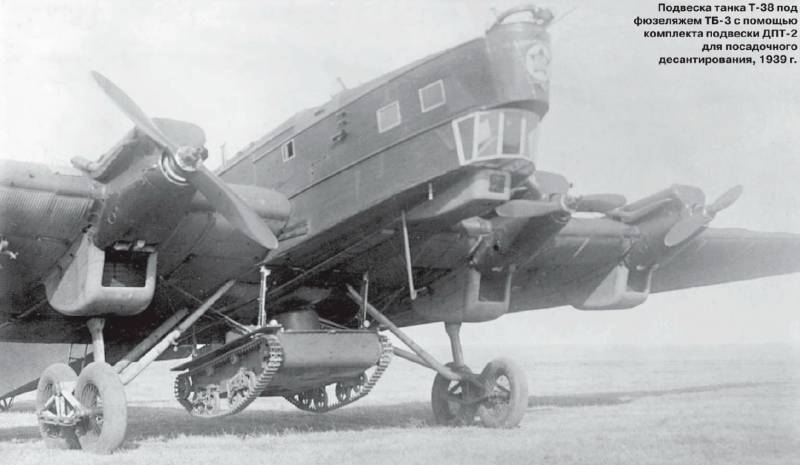
In May 1937 , the Soviet engineer Mikhail Smalko on its own initiative, began work on the armored vehicle, which could take off, land and engage in ground combat. As a basis he took a fast tank BT-7, which is essentially intended to further modify the aerodynamic properties, which were very important for flying model. In this case went far beyond Smalko, than planned Christi, his project had significant differences. Michael Smalko going to build a full-fledged flying tank. He hoped to raise to the sky heavy fighting machine with steel, and on the duralumin body. In addition to this, his flying tank had to get foldable wings, retractable feathering and strengthens the bow screw. According to his plan, Soviet flying tank could have more time to fly from one place to another, whereas the American project Christie suggested a one-time use of the discharged biplane wings, dropping its "kit" Christie tanks were to engage in battle, while re-raising in the air was not intended for them.
His project is called Michael Smalko MAC-1 (Small aircraft Smalko), It has also been known another name LT-1 (flying tank first). The most vulnerable places housing flying tank MAC-1 were covered by thick armor 3 to 10 mm. In this case the tank body has been substantially redesigned to improve its aerodynamic properties. Arming aviatanka were to form two large-caliber machine gun 12.7mm DC in the tower and one 7.62-mm machine gun ShKAS, who shot through screw with aviation synchronizer, full tank ammunition consisted of 5 thousands of rounds of ammunition for machine guns. Wings flying tank consisted of two halves: outer (armor) and sliding. The armor half of the wing was attached to the tank body and rotated around the mounting axis 90 degrees back, whereas the inner half of the retractable mechanism pulled outwardly special. In the unfolded position wingspan was 16,2 m. Retractable tail planned to fix on special carriages inside the tank, he had to move outwards and retracts back into the body simultaneously with wings. screw units, which consisted of two metal blades, in a combat situation it was to get out under the protection of special broneschitkov in the bow tank. As the power plant on the MAC-1 was used boosted to 700 HP. M-17 motor. Since the chassis and suspension battered he inherited from BT-7, speed performance cars were at the height of. The tank could unleash on the enemy barrage of machine-gun fire, moving on wheels at speeds up 120 kmh. Cruising flight speed should be about 200 kmh, planned flight range - up 800 km, ceiling - to 2000 m.
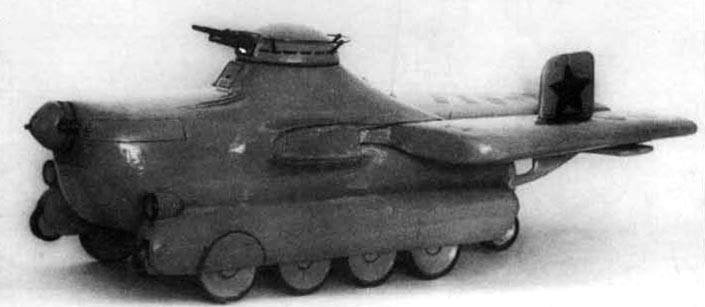
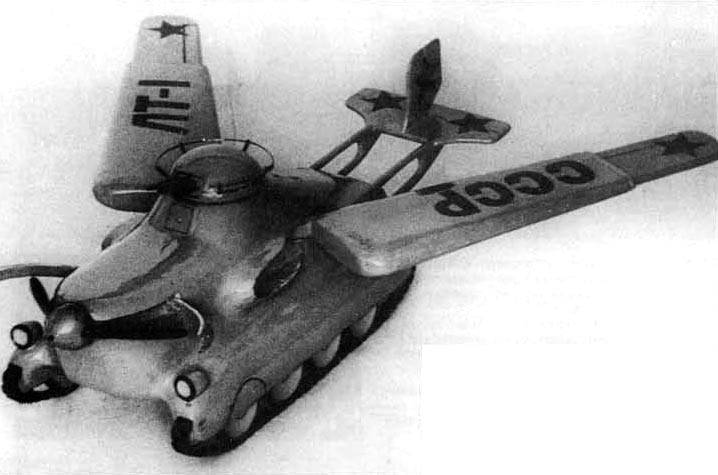
In the implementation of their plans Smalko moved beyond many of his colleagues, he managed to create a full-sized wooden model, with whom he had planned to start the first tests. However, beyond the layout and models did not get, and eventually he gave up his Smalko ideas. At the same time, the idea airlift tanks will not go away and work in this direction in the USSR continued. In particular, the idea of creating suspension were worked lung BT-7 tanks mechanism to distant aircraft bomber.
Most close to the real flying tank was able to approach the other Soviet designer and engineer Oleg Antonov. AT 1941 year after the start of the Great Patriotic War the staff, headed by Antonov, task was entrusted to build gliders, designed to deliver a variety of goods partisans. While working on this task, in Antonov came up with the idea to combine with each other and a light tank Glider. Work on the creation of a new flying tank, which received index A-40, began in December 1941 of the year. serial light tank T-60 was used to test. according to calculations, its chassis without making any changes to it should withstand the load takeoff. planned, that the flying tank will be disengaged from the tow-plane at a distance of 20-30 kilometers from the planned landing site, overcoming the distance as a glider.
Especially for this project was designed and built quite a large wooden box wing biplane, which is more reminiscent of the aircraft of World War I.. The wings and tail booms fastened to the body of the T-60 four point lower wing. After landing by turning just one knob resets the entire airframe, then the tank could soon join the battle with the enemy. To reduce air resistance during the flight turret gun should turn back. Any work to improve the aerodynamics of the hull has not been. It was assumed, that a driver aviatanka will pass the initial training pilot.
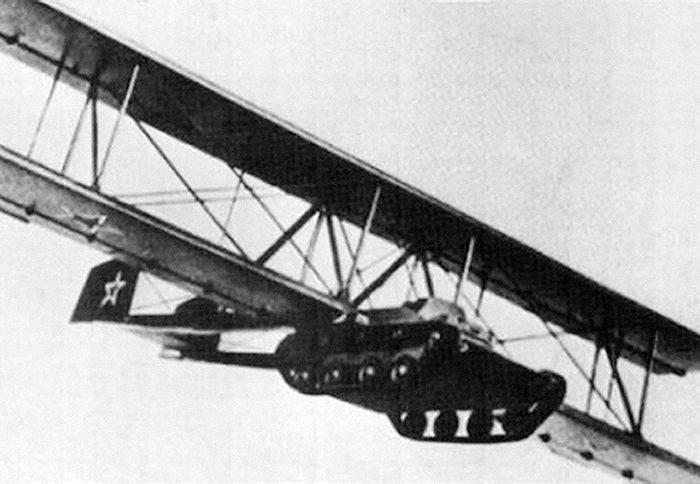
Glider for flying tank was ready in April 1942 in Tyumen, from there he was taken to carry out tests in Zhukovsky. The test was a test pilot Sergei Anokhin. As the tug-aircraft, it was decided to use a bomber TB-3, equipped with an AM 34RN uprated. The total weight of the structure A-flying tank 40 approaching 7,5 tons, of which 2 ton fell to themselves wooden wings. For this reason, the tank before the flight tried to maximally facilitate, removing from it unnecessary during flight nadgusenichnye shelves, tool boxes and other items. For better visibility the pilot was made a special periscope. Standard tank equipment was supplemented by the pilot's control stick, pedals to control the rotation of the rudders, and mehvoda appeared compass on the dashboard, altimeter and speedometer.
The first tests were carried out on the ground. Sergei Anokhin jogging on concrete strip airport. At this time, the tank of the aircraft supplied cable and started the run. From beneath the tracks T 60 sparks, it seemed, a little more and flying tank will be able to break away from the strip, However, a driver and part-time pilot revealed a cable lock and climbed into the sky only heavy bomber, a flying tank for some time continued to move by inertia, and then under its own power back to the parking lot.
The first real flight of the flying tank and became the last. he held 2 September 1942 of the year. Anokhin later recalled: "Everything was bearable, but was unusual be parachute inside the tank. I start the engine, turn speed, clanking their tracks, Tank taxis to the tail TB-3. Here Tank cling to the aircraft, in the observation slit can be seen, from under the bomber screws appear dust clouds, towline stretched. Long, snake-like rope in front of me turns into a steel rod. Then the flying tank shivers all over and starts moving, racing on tarmac faster and faster. Feels lightweight tilt to the left - the tank already in the air. Align unusual aircraft, while the tank climbs, rudders respond to my movements ".
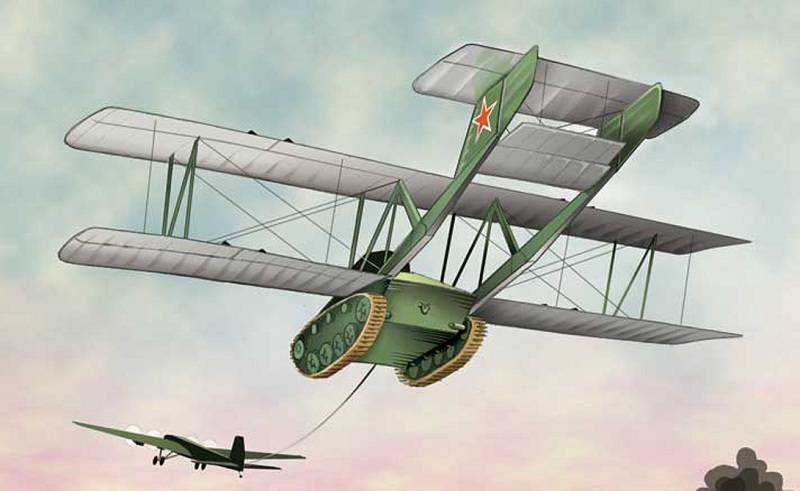
The first and only flight lasted no more 15 minutes. From the large air resistance to the airframe at the four-engine bombers begin to overheat motors. according to the team, received TB-3 bead, Sergei Anokhin unhooks flying tank of the aircraft and landing at the nearest airfield Bykovo. After planting Anohin, not dropping from the tank glider, I went to the command post of the aerodrome, where they were not warned about the appearance of an unusual car and did not know anything about testing. Landing extraordinary aircraft sparked alarm at the airport air. As a result, the calculation of the anti-aircraft battery test pilot pulled out of the tank and took his "captive". "Spy" was released only after his arrival at the airport fire and rescue team. Since the first flight of a winged tank in the world came to an end. flight results led to the conclusion that, that the capacity of existing engines is not enough for efficient operation of the flying tank. Aviatank A-40 could try to tow using a more powerful bombers Pe-8, but their ranks there was no more 70 units, so bring a rare and valuable long-range bomber test towing a flying tank so no one dared.
Information sources:
https://www.popmech.ru/weapon/7181-tanki-v-vozdukhe-fantasticheskoe-oruzhie
http://alternathistory.com/ostorozhno-v-nebe-letayushchii-tank
http://aviatank.ru/a-40
Materials from open sources







